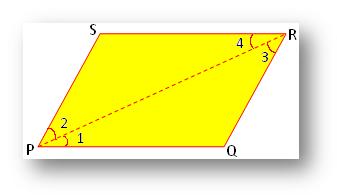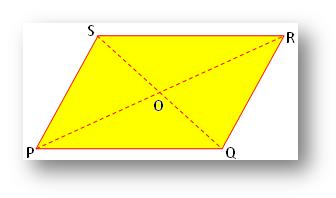Subscribe to our ▶️ YouTube channel 🔴 for the latest videos, updates, and tips.
Parallelogram
In a parallelogram; opposite sides are equal, opposite angles are equal and diagonals bisect each other.
Prove that in a parallelogram:
(i) the opposite sides are equal;
(ii) the opposite angles are equal;
(iii) diagonals bisect each other.
Proof:
Let PQRS be a parallelogram. Draw its diagonal PR.
In ∆ PQR and ∆ RSP,
∠1 = ∠4 (alternate angles)
∠3 = ∠2 (alternate angles)
and PR = RP (common)
Therefore, ∆ PQR ≅ ∆ RSP (by ASA congruence)
⇒ PQ = RS, QR = SP and ∠Q
= ∠S.
Similarly, by drawing the diagonal QS, we can prove that
∆ PQS ≅
∆ RSQ
Therefore, ∠P
= ∠R
Thus, PQ = RS, QR = SP, ∠Q
= ∠S
and ∠P
= ∠R.
This proves (i) and (ii)
In order to prove (iii) consider parallelogram PQRS and draw its diagonals PR
and QS, intersecting each other at O.
In ∆ OPQand ∆ ORS, we have
PQ = RS [Opposite sides of a parallelogram]
∠POQ = ∠ ROS [Vertically opposite angles]
∠OPQ = ∠ORS [Alternate angles]
Therefore, ∆ OPQ ≅ ∆ ORS [By ASA property]
⇒ OP = OR and OQ = OS.
This shows that the diagonals of a parallelogram bisect each other.
The converse of the above result is also true, i.e.,
(i) If the opposite sides of a quadrilateral are equal then it is a parallelogram.
(i) If the opposite angles of a quadrilateral are equal then it is a parallelogram.
(i) If the diagonals of a quadrilateral bisect each other then it is a parallelogram.
Parallelogram
Properties of a Rectangle Rhombus and Square
Practice Test on Parallelogram
Parallelogram - Worksheet
8th Grade Math Practice
From Parallelogram to HOME PAGE
Didn't find what you were looking for? Or want to know more information about Math Only Math. Use this Google Search to find what you need.




New! Comments
Have your say about what you just read! Leave me a comment in the box below. Ask a Question or Answer a Question.